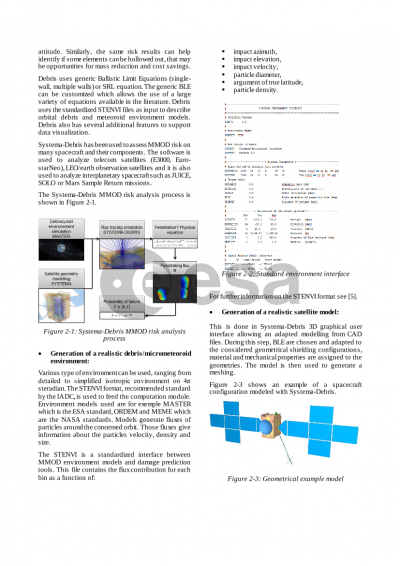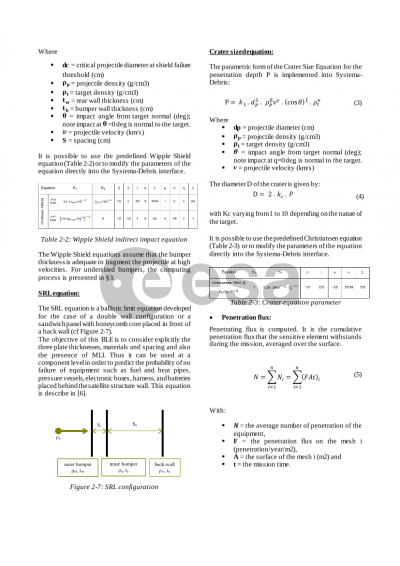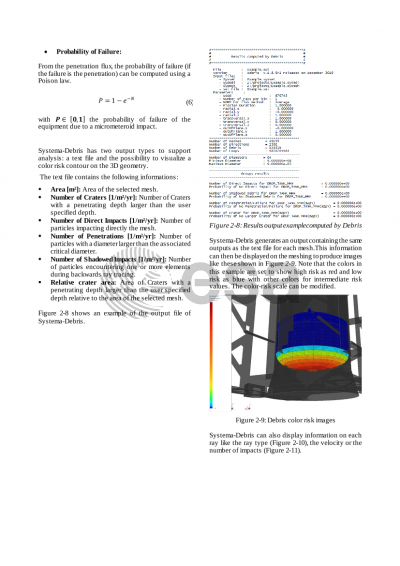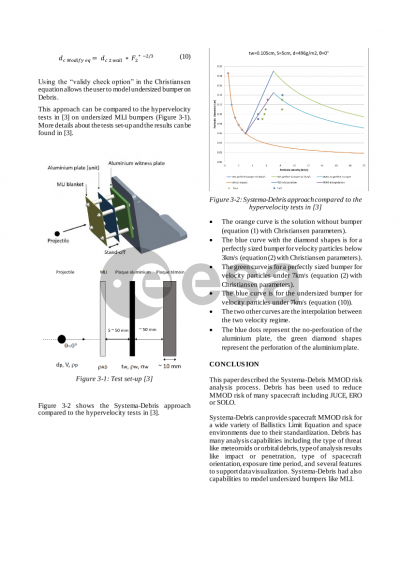Document details

Abstract
Due to their high velocity, micrometeoroids and orbital small debris (MMOD) represent a threat to the spacecraft or its components. Moreover, the numbers of debris in space is continuously increasing. It is thus necessary to assess the probability of spacecraft damage or failure due to a MMOD impact during its mission lifetime. The aim of a risk assessment is to identify the SC components sensitive to MMOD, provide inputs to assess the SC reliability and, if necessary, support the implementation of shielding to improve spacecraft survivability. Systema-Debris is a software that perform this kind of risk assessment analysis.
The paper presents the computing process of the risk assessment tool Systema-Debris and in particular the methodologies to design thin bumper protection to improve the spacecraft’s survivability from meteoroid and debris impact.
Indeed, In order to perform a risk assessment analysis for a spacecraft under a specific environment, it is necessary to evaluate whether or not the impacting particle will penetrate the sensitive target. A variety of different ballistic limit equations (BLEs) has been implemented for many types of structural wall configurations to identify the minimum critical particle diameter that can penetrate the target. These equations depend on several parameters like the size and the density of the particle, the material and diameter of the impacted target, the speed of the impacting particle, which makes the analysis difficult to perform without the support of a dedicated software.
The software calculates the number of penetrations by determining the number of particles that exceed the ballistic limits. It takes into account the particles environment and the shadowing of the spacecraft.
The main keys process of Systema Debris are:
- The generation of a realistic satellite model: This is done in Systema-Debris allowing a modelling from CAD files. During this step, material and mechanical properties are assigned to the model.
- Ray tracing: the fluxes from the environment model are projected onto the satellite geometry allowing a tracing of each particle path through the satellite structure. It tracks which layer of which material have been met crossed by the particle before impacting the equipment.
- Physical equation: application of ballistic equations allows the software to check whether or not the particle being traced penetrates the equipment.
- Penetration flux: penetrating flux is being computing. It is the average number of penetrations that the equipment withstands during the mission.
- PoF: From the penetration flux, the probability of failure can be computed using a Poison law.
The protection induced by SC parts like MLI or honeycomb can act as a bumper that protects the sensitive components. If this protection is undersized it may be necessary to design specific protection.
The Whipple shield equation [1] allows computing the critical particle diameter, and it is assumed that the bumper shield is well designed which means its thickness is sufficient to destroy the impacting particle. Reimerdes [2] modified the Whipple shield equation to take into account the bumper thickness. This methodology has been implemented in Systema-Debris to help the user to find mass effective protection concepts with undersized bumper.
C. Puillet shows in [3] that the use of the modified equation by Reimerdes on thin bumper like MLI is valid. As one of the solution to better protect a sensitive component is the use of MLI, this approach is routinely used on most of Airbus programs like JUICE or the incoming MSR-ERO spacecraft.
Illustration of the implementation of the methodology can be found in the paper.
[1] Christiansen EL. Design and performance equations for advanced meteoroid and debris shields. International Journal of Impact Engineering .
[2] Reimerdes HG, Noelke D, Schaefer FK. Modified Cour-Palais/Christiansen damage equations for double-wall structures. International Journal of Impact Engineering 2006.
[3] C. Puillet. Evaluation of Ballistic Limit Equations for standard Multi Layers Insulations with stand-off to units. 2019
Preview









